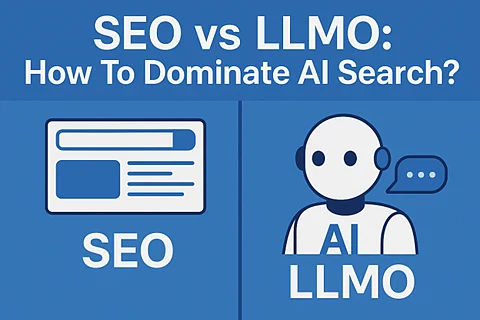

AI search engines like ChatGPT and Perplexity now handle over 90 million U.S. searches monthly but only 25% of businesses appear in their answers.
If you’re still relying only on traditional SEO, your content risks invisibility.
That’s where SEO vs LLMO becomes critical. We’ll show you how blending both strategies ensures your brand thrives in both Google and AI-generated responses.
By the end, you’ll know exactly how to adapt using data-backed tactics that dominate all search.
Large Language Model Optimization (LLMO) is the practice of optimizing your content so AI systems like ChatGPT or Gemini can find, understand, and use it effectively.
Unlike traditional SEO, which focuses on ranking well in search engine results pages (SERPs), LLMO targets how large language models process and generate answers.
It's about feeding the AI the right signals for your information to be included in its responses.
Large language models learn from massive amounts of training data, often billions of web pages and documents. They break down text into smaller units through tokenization, where words or phrases become numerical tokens the model understands.
When generating answers, the AI considers a specific chunk of text called the context window. Your content must fit clearly within this limited window to be relevant for the AI's response. Optimizing for these elements ensures the model accurately grasps and uses your information.
Adapting LLMO sets the stage for seeing how it differs from traditional SEO. Both aim for visibility, but their paths diverge sharply.
SEO targets search intent through exact keyword matches. It guesses what users want based on short queries. LLMO prioritizes conversational context instead. It analyzes full dialogues, like follow-up questions in AI chats. This shift demands natural language over rigid keywords.
Content structuring also splits these strategies. SEO leans on technical signals like backlinks and meta tags for ranking. LLMO ignores these. It relies on entity-rich content that defines concepts clearly. Your text must stand alone with authoritative context—facts, dates, or data that prove expertise without external links.
One critical gap is LLMO rewards depth on specific subtopics. SEO spreads focus across broader terms. For example, explaining "neural network training steps" in depth satisfies LLMO’s hunger for precision. SEO would chase higher-volume terms like "AI basics”.
Optimizing content for AI-driven search requires shifting from keyword-centric tactics to strategies that align with how large language models (LLMs) process information. Here’s how to implement actionable methods that boost visibility in AI-generated responses.
Entities—unique concepts like brands, people, or products help LLMs understand your content’s context. Unlike keywords, entities create semantic relationships.
For example, mentioning "CRM software" alongside "customer data management" signals topical depth.
To optimize, use consistent entities across all platforms (e.g., your brand name on websites, social media, and directories).
This consistency builds contextual relevance, making LLMs associate your content with specific queries. Including verifiable data like original statistics also strengthens authority, as LLMs prioritize credible sources.
Technical foundations ensure LLMs can access and trust your content. Implement schema markup with @id properties to define entities clearly across pages (e.g., https://example.com/#organization). This connects data for knowledge graphs, which LLMs use for verification.
Update content regularly for freshness signals, as outdated information reduces citation rates. Additionally, optimize site speed and minimize JavaScript. LLMs favor fast-loading pages, similar to traditional search engines, but prioritize machine-readable structure over visual design.
Learning how LLMs affect search results is critical. AI-generated answers now replace traditional SERPs for 27% of queries, making LLMO essential for visibility. Without it, your content becomes invisible where users increasingly search.
LLMO demands technical adaptation. Pages optimized for AI readability—clear section headers, concise explanations, and verifiable claims—rank higher in LLM outputs.
Unlike traditional SEO, authority signals now come from cross-referenced facts, not backlinks. Ignoring this risks irrelevance as AI answers dominate search.
User intent has transformed from keyword searches to full conversations. People now ask AI tools multi-step questions, requiring new optimization approaches.
Track visibility metrics in Google Search Console’s AI overview reports. These show how often your content appears in AI-generated answers. Brands balancing SEO vs LLMO see 2x retention because they align with conversational queries. Also monitor dwell time—pages satisfying user intent keep visitors engaged longer.
Search behavior now blends voice and text. Optimize for long-tail phrases like "best AI website builder for e-commerce startups" instead of "AI website builder." This matches how people naturally speak to AI.
SEO and LLMO are not rivals, they're partners. Ignoring either risks visibility as AI reshapes search.
Audit your content today. Identify gaps in entity clarity, contextual depth, and technical foundations. Tools like Google’s AI Overview reports reveal where LLMs overlook your pages.
Winning the SEO vs LLMO game requires agility. Start taking small steps by adding schema markup to key pages, rewrite one FAQ section for conversational clarity, and cite original data. Track changes in AI answer appearances monthly.
Future demands this dual focus. Sites blending SEO keywords with LLMO’s contextual authority dominate all search formats.
